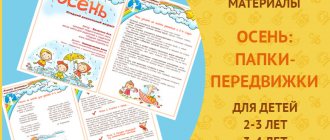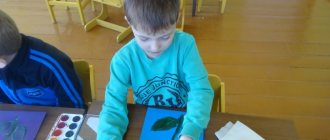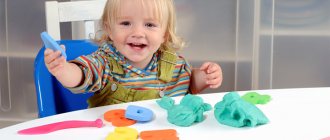Educational and research project “Sand and properties”
Children conclude: dry sand is free-flowing and can move.
Experiment 4. “Sandstorm”
Purpose: to give an idea of the properties of dry sand. Explain why it is inconvenient to play with sand in strong winds.
Material: sand, cocktail straws, transparent plastic container (jar).
Children examine the prepared “sandbox” (a jar filled with a thin layer of sand). Together with adults, they create a hurricane - they blow into the sand into a tube and find out what is happening and why (since the grains of sand are small, light, do not stick to each other, they cannot hold on to each other or to the ground with a strong stream of air) .
Experiment 5 “Is it possible to draw with sand?”
Purpose: to introduce the method of making a drawing from sand.
Materials: sand, water, sheet of white paper, glue stick.
Children are invited to look at the sand: what color it is, try it by touch (loose, dry). What is sand made of? How can you play with dry sand? Is it possible to paint with dry sand? Draw something on thick paper with a glue stick, and then pour sand onto the glue. Shake off excess sand and see what happens.
Experiment 6. “Where is the water?”
Purpose: to introduce the property of sand to absorb water.
Material: container with sand, water,
Invite children to find out the properties of sand by testing it by touch (loose, dry). Children pour cups with the same amount of water (pour just enough water to completely sink into the sand). Find out what happened in the container with sand, why the water left (seeped through the sand) where there are more puddles after the rain (there are no puddles on the asphalt, in the sandbox).
Experiment 7 “Sculpting from wet sand”
Goal: to highlight the properties of wet sand: wet sand is loose, you can sculpt different figures from it.
Materials: container with sand, water, stencils, molds
The teacher invites the children to build sand pies.
- You have molds, let's pour sand in there and make Easter cakes. Work carefully and carefully pour the sand into the molds.
- The result was Easter cakes (Children's answers)
- Why didn’t it work out? (Sand is dry)
- What needs to be done so that you can sculpt from sand? (children's assumptions)
— Who knows what will happen if you pour water into the sand (children’s answers)
- Let's check.
The teacher, with the help of 1-2 children, waters the sand from a watering can.
- Touch it and tell me - is it dry or wet? (Wet)
Let's repeat it all together: If you pour water into sand, it will become wet.
-That's right, this sand is damp, wet. He's cold. Look, wet sand flows just like dry sand (Show to children)
— Of course, wet sand doesn’t fall. You can make Easter cakes from wet sand. Let's try. Take the molds and carefully place wet sand into them. Tap the sand like this with a scoop and compact it. Carefully invert the mold with sand onto the stand. Tap the bottom again with the scoop. Remove the mold. What happened (Kulichik)
MAGAZINE Preschooler.RF
Project "Magic Sand"DEPARTMENT OF EDUCATION OF THE ADMISTRATION OF PUROVSKY DISTRICT MUNICIPAL BUDGETARY PRESCHOOL EDUCATIONAL INSTITUTION "KINDERGARTEN "GNEZDYSHKO" P. PUROVSK PUROVSKY DISTRICT
Yamalo-Nenets Autonomous Okrug, Purovsky district, Purovsk settlement,
Prepared by: Educator A.N. Iskenderova p. Purovsk 2015
Due to their age, all children love playing with sand and water; children’s interest in these games and their development depend on how much the teacher, firstly, taught the child to identify materials and their properties by sensory means, and secondly, managed to bring to consciousness children the possibility of using these materials and, thirdly, found application for them in specific children's activities.
The development of games begins with the creation of appropriate conditions that meet both hygienic and pedagogical requirements. Sand used by children requires constant care. It is periodically cleaned, changed, watered, and mixed well. Since children love to play with sand and water at any time of the year, these materials should be available in sufficient quantities not only in courtyards and boulevards, but also indoors. Interest in playing with water is supported by the addition of new toys made of different materials, with different properties that are sometimes unexpected for children.
Experimentation is the leading activity for young children.
Type of project: educational and research
Project duration: long-term
Subject of research: inanimate nature (sand, water)
Project participants: pupils of the younger group (3-4 years old, teacher)
The goal of the project: to introduce children to the properties of inanimate nature: sand, water and the formation of cognitive experience and practical skills of children in research activities.
Project objectives:
- stimulate the needs of knowledge of the surrounding world
- activate children's creative abilities
- reveal to children the properties of inanimate nature
- create conditions for children's experimental activities
- develop curiosity through observation and hands-on experimentation
- teach children to draw conclusions based on experiments
- foster respect for natural resources
Forms of project work with children:
- Reading and viewing fiction (nursery rhymes).
- Playing games with sand and water.
- Replenishment of the subject-developmental environment of the group;
- Experimental activities
Project stages:
Stage I – PREPARATORY
- Defining the goals and objectives of the project
- Selection of material
- Revealing children's knowledge about inanimate objects (sand, water)
- Development of consultation for parents
Stage II – CONTENTIVE
- Properties of sand: dry, wet, crumbles, molds;
- Transforms into: wet sand, dry sand;
- Conversations;
- Observations;
- Experiments;
EXPERIENCE No. 1
Purpose: to highlight the properties of sand: flowability, friability, you can sculpt from wet sand; introduce the method of sand painting.
Materials: sand, plastic glasses, watering cans with water, molds, magnifying glasses, album sheets, glue sticks.
The teacher suggests looking at the sand: what color, pour it into glasses, pour it out, touch it (loose, dry). What is sand made of? We can examine grains of sand through a special device called a magnifying glass. The magnifying glass has magic glass built into it; it turns all small objects into large ones (they examine them). The grains of sand are small, round, and do not stick to each other. Is it possible to sculpt from dry sand? Why? What needs to be done so that we can sculpt from sand? Children use watering cans to water the sand.
Can you sprinkle wet sand in a stream? But it can take any shape until it dries (children sculpt with molds). Why is this happening? When the sand gets wet, the air between the grains of sand disappears, they stick together, as if holding each other by the handles (you can look at dry and wet sand again through a magnifying glass). You can draw on a flat surface of wet sand with a stick (shows).
EXPERIENCE No. 2
Goal: to consolidate ideas about the properties of sand (flowability, friability, you can sculpt from wet sand, show that sand allows water to pass through; develop curiosity and constructive skills).
Materials: sand center, scoops, rakes, watering cans, pebbles.
What is this? (dog, car, duck). All toys have their own house. A dog lives (in a kennel, a car... (in a garage, a duck... (in a pond, lake). Let's build a house out of sand for each toy. What kind of sand is best to build from? How to make it wet? (Children water the sand). Why sand? became wet? Where does the water go? Children are building a kennel and a garage
Experience No. 3.
"Sand can move"
Take a handful of dry sand and release it in a stream so that it falls in one place. Gradually, a cone forms at the site of the fall, growing in height and occupying an increasingly larger area at the base. If you pour sand for a long time, then alloys appear in one place or another. The movement of sand is similar to a current.
EXPERIMENT No. 4 “Wet sand”
Target. Introduce children to the properties of wet sand.
Materials. Wet sand, sand molds.
Take wet sand in your palm and try to sprinkle it in a stream, but it will fall from your palm in pieces. Fill the sand mold with wet sand and turn it over. The sand will retain the shape of the mold.
Wet sand cannot be poured out of the palm of your hand; the backwater can take any desired shape until it dries. When sand gets wet, the air between the edges of the sand grains disappears, and the wet edges stick to each other.
- Games;
Game "Magic fingerprints on the sand"
Goal: familiarization with the properties of sand, development of coordination of movements
Contents: The teacher and the child leave prints of their hands and feet on the wet sand, and then complete them or add pebbles to create funny faces, fish, octopuses, birds, etc.
Game "Guess what's hidden in the sand"
Contents: The child is invited, using miniature figures, to build a sand picture called “What does not happen in the world . After completing the work, the child is asked to talk about what happened. Try to compose a fairy tale with him.
Game "Homemade Waterfall"
Goal: development of hand motor skills
Contents: For this game, you will need any toys that can be used to pour water: a watering can, a small bowl, a small jug or a simple plastic glass. The baby draws water into a container and, pouring it out, creates a noisy waterfall with splashes. Please pay attention to the crumbs that the higher the waterfall, the louder it “makes noise”. And if you tint the water, the waterfall will turn out to be multi-colored.
Pouring dry sand through a funnel
Purpose: To introduce children to the properties of dry and wet sand.
Content. The teacher leads a group of children (no more than 8 people) to the sandbox. Hands out bottles, buckets, and molds to children.
Shows how sand is poured through a funnel, how it is poured from a bucket into a mold. Then he pours some of the sand, mixes it with a scoop and shows that wet sand cannot be poured, but it can be sculpted into different shapes. The teacher shows the children how to fill the mold, press the sand with their fingers or a scoop, tip the mold onto the side of the sandbox, and decorate the “pie” or “cake .
Games with a sieve
Goal: Development of tactile sensations. Introduction to the properties of sand. Content. The teacher shows how to sift sand through a sieve. The game will become more interesting if, while sifting through the sand, the child finds small toy figures (for example, from Kinder Surprise )
Game "Mouse holes"
Goal: familiarization with the properties of sand, development of coordination of movements
Contents: The child, together with the Teacher, digs small holes - minks with his hands or a shovel. Then the mother voices a toy, for example, a little mouse, squeaks, praises the baby for such a wonderful house, pushing the toy into it.
Game "Fences"
Goal: familiarization with the properties of sand, development of coordination of movements
Contents: The child sculpts fences in a circle with his hands. Behind such a fence you can hide a bunny from the evil gray wolf. Or roll a truck along it.
Game "Ducks are swimming"
Purpose: to give an idea that objects “float” , about the numerical definition of “one” , “many” .
Content. The teacher floats rubber toys in the water. “Look how the duck swims. Now I will swirl the stick in the water (makes circular movements with the stick). The duck is moving. That's how interesting!
And now, Kolya, you have a stick on you, twirl it, etc. to the other children.
There was one duck, but now how many?
Afterwards, the teacher suggests taking the toys out of the water and wiping them with a cloth. They are wet, wipe the toys, now they are dry.
Put the toys back where they belong. Let's pour the water out of the basin. That's how it flows.
Game "Water Takes Shape"
Purpose: to give the concept of floating and sinking objects, heavy and light objects. Conclude that light objects float and heavy objects sink.
Content. For this game you will need: an inflatable ball, a rubber glove, a plastic bag, a plastic cup. The baby fills the ball, glove or bag with water using a plastic cup. Parents should draw his attention to the fact that water takes the shape of the object into which it is poured.
Game "Hot and cold"
Purpose: To give an idea of cold, warm and hot water.
Content. Children sit on chairs in a semicircle around the table. The teacher sets up a basin or bathtub and tells the children that now the Tanya doll will bathe. He pours cold water and lowers the doll. The doll “pops out” . She doesn't want to swim. Why? The water is cold. Children come up and touch the water with their hands.
I'll add hot water, it will become warm. Children make sure the water is warm. Now the doll is placed in the basin again, and she bathes with pleasure.
Activation of the dictionary: cold, warm, hot.
Game “I bake, bake, bake”
Goal: familiarization with the properties of sand, development of coordination of movements, hand motor skills.
Contents: The child “bakes” buns, pies, and cakes from sand. To do this, the baby can use a variety of molds, pouring sand into them, compacting them with his hand or a scoop. “bake” pies with your hands, transferring wet sand from one palm to another. Then the child “treats” the dolls with pies
Game "Find the ball" .
Goals: familiarization with the quality of objects - size, shape.
Contents: The teacher buries a small ball in the sand and asks the child to find it. First, you can bury the ball in front of the baby’s eyes, then so that he cannot see the adult’s actions. Gradually complicating the task, the teacher buries two objects, for example a ball and a cube, then asks to find one of them. You can bury objects of the same shape, but of different sizes.
Stage III – FINAL
Expected result:
By the end of the project activity, children should know that:
- Water is a liquid, it pours and drips, it can change color and taste, it is transparent, odorless, it can be warm, cold and hot. Water is the source of life.
- The sand is loose, damp, dry, molds when wet.
- Develop the ability to observe, pronounce, name, compare, and draw simple conclusions.
| Next > |


